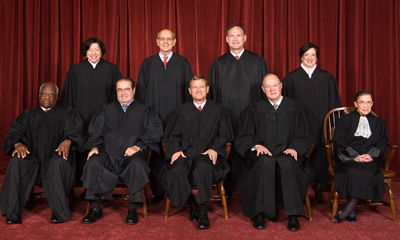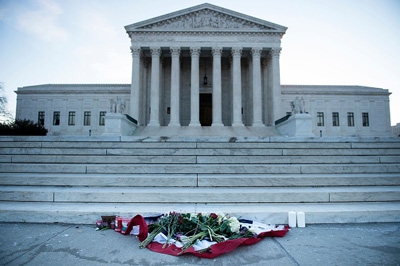A very
different court
By Erwin
Chemerinsky
 |
| U. S. Supreme Court -- Collection of the Supreme Court of the United States. |
The most
important lesson from the just completed term of the U.S. Supreme Court is that
there are no longer five votes for a conservative result. From 1971, when
President Richard M. Nixon had his fourth nominee confirmed for the court,
until Justice Antonin Scalia died on Feb. 13, there were at least five justices
appointed by a Republican president and who were ideologically conservative. But
no longer.
Analysis
The most
important cases of this October 2015 term fit a clear pattern. In some, Justice
Anthony Kennedy voted with the conservative justices – John Roberts, Clarence Thomas,
and Samuel Alito – and the court then deadlocked 4-4. Or Justice Kennedy joined
with justices Ruth Bader Ginsburg, Stephen Breyer, Sonia Sotomayor and Elena Kagan
and there was a liberal result. But rarely could the conservative justices gain
a fifth vote for their position.
A deadlocked
court
When the
court splits 4-4, the lower court ruling is affirmed without opinion and without
there being any Supreme Court precedent. Sometimes this upheld a liberal result
and sometimes a conservative one, depending on what the lower court decided. For
example, the court’s tie in Friedrichs v. California Teachers Association means that the government can continue to require that employees pay the share
of the union dues that go to support the collective bargaining activities of
the union. This is enormously important for unions and their role in the
political process. By contrast, in United States v. Texas, the court’s 4-4
deadlock means that the lower court’s nationwide preliminary injunction against
President Barack Obama’s executive action on immigration – Deferred Action for
Parents of Americans – remains in place.
 |
| Flowers are placed in front of the U.S. Supreme Court on Feb. 14, 2016, in Washington after the sudden death of Justice Antonin Scalia. Brendan Smialowski/AFP/Getty Images |
There is
no doubt that both of these cases would have been 5-4 decisions in favor of a
conservative result if Justice Scalia were still on the court. Likewise with
Justice Scalia, the conservatives would have had a majority in Zubik v.
Burwell to strike down a provision that requires that insurance providers
for religious institutions, like a Catholic university or Little Sisters of the
Poor, provide contraceptive coverage for women employees. But without a fifth
vote, the court obviously was deadlocked 4-4 and sent the case back to the
lower courts for consideration of a compromise proposed by the justices.
Kennedy
joins the liberals
In some
of the most high-profile cases, Justice Kennedy joined the liberals. In Whole
Women’s Health Center v. Hellerstedt, the court, 5-3, declared
unconstitutional a Texas law imposing significant restrictions on abortion
providers. The Texas statute required that any doctor performing an abortion
have admitting privileges at a hospital within 30 miles and that all places
where abortions are performed have surgical quality facilities even if no
surgical abortions are performed there. This would have closed 75 to 80 percent
of all the facilities in Texas where abortions are provided. The court, though,
concluded that there is no evidence that these restrictions protect women’s
health and held that they are an unconstitutional undue burden on women’s right
to abortion.
Most
importantly, Justice Breyer’s majority opinion stressed that it is for the
judiciary to independently evaluate whether a law limiting abortions is
justified by a health benefit to women that outweighs its burden in access to
abortions. Since 2010, state governments have adopted over 290 new laws
restricting access to abortion and the court’s decision means that a great many
of these statutes are likely unconstitutional.
In Fisher
v. University of Texas, Austin, the court, in a 4-3 decision with Justice
Kennedy writing for the majority (Justice Kagan was recused), upheld the
University of Texas’ affirmative action program. A contrary decision could have
put in jeopardy affirmative action programs throughout the country. Although
the court reaffirmed the existing law, the tone of Justice Kennedy’s opinion
signaled a greater willingness than previously of the court to allow
affirmative action programs. The court declared: “Considerable deference is
owed to a university in defining those intangible characteristics, like student
body diversity, that are central to its identity and educational mission.”
A
college or university wishing to engage in affirmative action must prove a
compelling interest, such as the need for diversity on its campus, and it must
show there is no race neutral way to achieve its objective. The school must
continually reexamine its affirmative action program to be sure it continues to
be necessary. But these are manageable tasks.
This
case, though, will not directly affect California’s public colleges and universities
because of Proposition 209, which prohibits government entities in the state
from discriminating or giving preferences based on race or sex in education,
contracting, or employment.
A
conservative outcome
The only
major decision where the conservatives prevailed in an ideologically divided
case was in Utah v. Streiff, which held that evidence gained after an
illegal police stop is admissible if the police learn of an outstanding warrant
for the person’s arrest. Justice Breyer joined with Justices Thomas, Roberts,
Kennedy, and Alito to create the majority.
The
police illegally stopped Edward Strieff outside a home where drug dealing was
suspected. The officer asked his name and did a search for outstanding
warrants. A
warrant was found and Strieff was arrested based on it. A search of Strieff then
was done incident to his arrest, and he was found to be in possession of
illegal drugs.
The issue before the Supreme Court was whether the evidence had
to be excluded from the trial because it was the direct result of the police
officer’s violating the Fourth Amendment and illegally stopping Strieff. Long
ago, the Supreme Court held that the products of police violations cannot be
used as evidence by prosecutors because they are “the fruit of the poisonous
tree.” Otherwise, police would have too great an incentive to violate the law.
But the Supreme Court, in a 5-3 decision, held that the evidence
was admissible against Strieff. Justice Clarence Thomas wrote the opinion for
the court and said that once the police officer discovered that there was an
outstanding warrant on Strieff, it made the resulting search as part of his
arrest permissible. The court said that the outstanding arrest warrant for
Strieff's arrest was a critical intervening circumstance that broke the causal
chain between the unconstitutional stop and the search.
Justices
Sotomayor and Kagan wrote dissenting opinions that lamented that the decision
gives the police an incentive to stop people in violation of the Fourth
Amendment knowing that if there is an outstanding warrant, a search can be done
and any evidence gained will be admissible. Justice Sotomayor wrote: “[T]his case tells
everyone, white and black, guilty and innocent, that an officer can verify your
legal status at any time. It says that your body is subject to invasion while
courts excuse the violation of your rights. It implies that you are not a
citizen of a democracy but the subject of a carceral state, just waiting to be
cataloged.”
A
good year for criminal defendants
There
also were a number of instances in which the court ruled in favor of criminal
defendants in cases that were not closely divided. For example, in Montgomery
v. Louisiana, the court held, 6-3, that its earlier decision in Miller
v. Alabama applies retroactively. In Miller, the court concluded that
it is cruel and unusual punishment in violation of the Eighth Amendment to have
a mandatory sentence of life in prison for a homicide committed by a juvenile. The
effect of Montgomey is that all who received such life sentences before
2012, when Miller was decided, can take advantage of that ruling.
Similarly,
in Welch v. United States, the court held, 7-1, that its decision a term
earlier in Johnson v. United States – which declared unconstitutional on
vagueness grounds the “residual clause” of the Armed Career Criminal Act –
applies retroactively. The Armed Career Criminal Act provides that if a person is convicted of a crime
involving the use of a firearm and the individual has three or more earlier
convictions for a “serious drug offense” or a “violent felony,” the prison
term is a minimum of 15 years and a maximum of life. The act defines violent
felony as: “any crime punishable by imprisonment for a term exceeding one year
... that ‘(i) has as an element the use, attempted use, or threatened use of
physical force against the person of another; or (ii) is burglary, arson, or
extortion, involves use of explosives, or otherwise involves conduct that
presents a serious potential risk of physical injury to another.’ ”
In Johnson,
the court declared the last clause – “otherwise involves conduct that presents
a serious potential risk of physical injury to another” – to be
unconstitutionally vague. In Welch, the court said that this applies
retroactively and benefits the thousands of people sentenced under this clause
before Johnson.
In Foster v. Chatman, the court strongly reaffirmed
that it violates the Constitution for lawyers to exclude prospective jurors
based on race. Timothy Foster was prosecuted for murder in Georgia. There were
four prospective African-American jurors and the prosecutor used peremptory
challenges to exclude each of them. Foster’s lawyer objected, but the trial
judge found that the prosecutor had offered sufficient explanations apart from
race and overruled the objection. Foster was convicted and sentenced to death.
Many
years later, Foster’s lawyer filed a request under the Georgia Open Records Act, seeking
access to the state’s file from his 1987 trial. The file contained stunning
evidence of race discrimination in the exercise of peremptory challenges. One
document was a list of prospective jurors with the names of the black prospective
jurors highlighted in bright green. A legend in the upper right corner of the
document indicated that the green highlighting “represents Blacks.” The letter
“B” also appeared next to each black prospective juror’s name. They were ranked,
“B#1,” “B#2,” and “B#3,” respectively, indicating the prosecutor’s preferences
among them. Another document in the file was handwritten and titled, “definite
NO’s,” it listed six names and included all of the prospective African-American
jurors.
Even
with this evidence, the Georgia courts found no constitutional violation. But
the Supreme Court in a 7-1 decision reversed it, with Chief Justice John
Roberts writing for the court and only Justice Clarence Thomas dissenting. The court
concluded that Foster’s constitutional rights were violated because the
“prosecutors were motivated in substantial part by race when they struck”
prospective jurors.
Finally,
in Birchfield v. North Dakota, the court struck a compromise of sorts
and held that a state may require that a driver consent to breath tests, but
not blood tests, when being investigated for driving under the influence. Justice
Alito wrote for the court and said that breath tests are a minimal intrusion of
privacy, involving no more than that a person blow into a tube. By contrast,
blood tests require piercing the skin and are a much greater intrusion to
privacy.
The
future
Since
1960, 78 is the average age at which a Supreme Court justice has left the
bench. There will be three justices 78 or older when the next president is
inaugurated in 2017: Justices Ginsburg, Kennedy and Breyer. Especially if it is
a two-term president, it seems likely that he or she will have several picks
for the high court. Also, of course, it is uncertain as to who will replace
Justice Scalia. For liberals and conservatives, Democrats and Republicans, one
of the most important issues in the coming election is who will fill these
vacancies on the Supreme Court.
Erwin
Chemerinsky is dean and distinguished professor, Raymond Pryke Professor of
First Amendment Law, at the University of California Irvine School of Law.